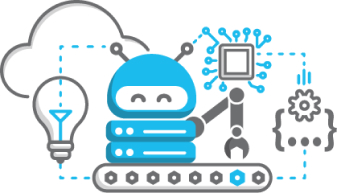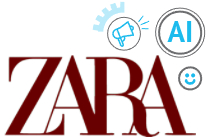Contents
It’s hard to imagine our lives without the help of artificial intelligence tools in today’s world. These tools have seamlessly stepped in to handle the tasks we dread or cannot do. Some tasks need more processing power than our brains can provide, or they might be too difficult without the assistance of AI. So, the impact of AI on our lives is quite significant, making our tasks more manageable and our lives more efficient.
How are AI tools integrated into our daily lives, and its practical value for developers?
Many domains in which companies operate have changed due to the active development of AI coding tools in recent years.
For example, when GitHub Copilot first came out, many developers were worried it might take their jobs because this AI tool learned how to code. However, GitHub Copilot is not very useful without an operator (a person who writes the code and knows what is being generated). Even though it’s a helpful tool for developers, it still needs a human to make it work properly.
Indeed, the wave of artificial intelligence has influenced every corner of our daily lives. Chat GPT from OpenAI is changing how we use search engines and is even helpful where traditional search engines might fail. It’s also stepping into areas usually covered by other services.
Again, some new AI tools have learned to write and draw, which partially replaces the work of artists and authors. But since there are many legal issues to be agreed upon, we’re not quite ready to use them widely.
For instance, Amazon is growing its machine learning business and has several tools that can be used in different areas. These tools can even help spot fraud, showing how useful AI can be in keeping transactions safe and fixing security vulnerabilities.
Therefore, it is worth considering why we use these tools and what we get when we use them. In today’s fast-paced world, staying ahead of technology and leveraging AI code tools to work for you without requiring you to invest extra time and effort in keeping up with them is essential to remain up to date.

The first reason to use AI tools for developers is to automate routine tasks
For example, AI works well with test automation. Many code completion tools generate code and can improve code quality, so the project becomes better. AI can also identify code errors, find potential bugs, automate testing, and create more accurate test cases. AI software development tools optimize code performance.
AI can give you an example of how to perform a specific task
Several AI code-writing tools can help you develop a solution faster and easier. GitHub Copilot can give you an example of making your code faster using particular tools you have yet to use.
Thanks to its help, you can learn new functions and methods to improve your developing skills. Also, artificial Intelligence is reaching the level where it can help manage resources by analyzing project data and human project history. It can make suggestions and a basic plan on how to build a team for this project, what the project deadlines would be, what the optimal resource allocation for this project is, etc.
AI can also help with collaboration between development team members, providing ideas and facilitating communication. With AI development tools, you can quickly generate many ideas. There are already some tools that help to distribute tasks in the team and communicate better.
Best AI tools for developers
1. Github Copilot AI software development tool
Since it was mentioned above, let’s look at this one of the best AI coding tools. GitHub Copilot is an AI-powered software development tool released a long time ago. This coding assistant is designed to help users write code more efficiently. It gives smart hints to complete functions in the code or write methods based on the description. In general, Copilot provides intelligent code suggestions and snippets based on users’ descriptions or comments, saving developers significant time and effort, especially for routine coding tasks.
If we have a comment describing the method’s functionality, it can suggest how to write it quickly. For example, a simple function to write data into a file based on a comment – immediately generates a hint about a possible piece of code that can make the program write the data into the file.
It’s important to note that while GitHub Copilot can generate code quickly, it may not always be error-free or suitable for integration into a larger project. The errors that may occur have to be controlled and detected at the writing stage. Therefore, developers should review and test the generated code before using it in their projects.
You need to test whether the function will work or be entirely correct.
Of course, you can give a command to the AI itself to test it. For example, ask the machine to test it in 10 cases. It will execute the command, describe the methods used, and show the result.
In general, the idea of GitHub Copilot is to help you write the code. Also, if you have a large code base, GitHub Copilot can analyze this base and rely on the context of previous projects, which will speed up the development process. GitHub Copilot can analyze entire codebases to provide context for the code being developed, which can help developers create more consistent products with high code quality. This feature can save developers time and lead to more efficient coding practices.
2. TabNine
TabNine is another AI coding tool that improves speed and efficiency during development and delivery. It offers similar features to GitHub Copilot, such as intelligent code completion suggestions and code snippets based on user input. However, TabNine is more focused on privacy and security, making it an ideal solution for developers with sensitive data.
In addition, the TabNine code generator offers an enterprise version that allows users to train a custom AI model on their machine. This feature is handy for larger projects or for users who have specific requirements for their codebase.
If Copilot has now developed to the point where it is available in the browser, TabNine focuses on developing and delivering your product or code.
Both GitHub Copilot and TabNine are examples of the best AI development tools. They offer valuable solutions for developers who want to streamline their coding experience and save valuable time. However, it’s essential to keep in mind that these code-generation tools should be used as aids rather than replacements for manual coding practices. Developers should always thoroughly review and test their code before integrating it into their projects to ensure it meets their specific requirements.
3. Framer X
Framer X is an AI tool specifically designed for web designers who want to quickly generate a basic design based on specific requirements. The rendered page view can be taken as a starting canvas and further developed according to individual needs. The generated design is quite diverse, engaging, and not simple. Although the design may be flawed, Framer X can pull up relevant information from the network to provide design solutions and brief information. Web designers can use this tool for inspiration and reference, allowing them to create unique and innovative designs. After a few attempts, you will get something better and ready to use. Framer X uses a trained model of Chat GPT, which is trained to generate basic layouts with specific texts that it can find on the network.
4. GPT API chat
Particular attention should be paid to the GPT API chat, which has become popular and helpful for all network users.
ChatGPT stands out as a leading choice in the realm of AI tools. Renowned as the forefront AI solution of our time, it has garnered widespread adoption. This Large Language Model is trained on a large amount of information and can assist in various tasks such as generating text, images, code, translation, answering questions, and problem-solving.
Previously, many popular tools could be used for different tasks. For example, Wolfram Alpha was used to solve math problems, and Dall-E was used to generate images. Chat GPT became an all-in-one tool combining several AI-powered tools previously used for different tasks. This integration has made it easier for users to access various features in one place. However, it’s important to note that copyright issues may still arise when using AI-generated content.
To get the most out of Chat GPT, it’s essential to provide a good description of the task or project you’re working on. For example, if you need to generate an image, you should give a detailed description of what type of image you need, what should be happening on it, what style you want, whether it needs upscaling or not, and whether it’s one image or many variations of one.
The last rule, as always, remains the same – experimentation. It would help if you experimented on dozens of image generations, as it may not always provide the correct answer.
Here, we should focus on the idea. Using these images somewhere in production or for business is not easy. We will never know which images were used to generate our query. So, these services are designed more for inspiration rather than replacing one’s work.
Chat GPT may not always answer questions correctly. This should be kept in mind as well.
It’s also important to consider that Chat GPT is not trained only in English. It understands that languages that are not very popular are rarely shown in search engine results. This is a significant advantage for users worldwide who might have faced language translation issues in their work.
In addition to the numerous features mentioned above, Chat GPT has data analysis capabilities. Users can quickly analyze a CSV file or any other data by inputting it into Chat GPT. It will then investigate and assist in making the correct conclusions from the text or data in different formats.
Moreover, users can train the Chat GPT on specific data to perform certain tasks better. By training the model, it can learn from past experiences and enhance its capabilities, making it easier for the user to accomplish their desired goals.
The chat GPT Language model has many versions, depending on which tools you are interested in.
The plus version, for example, gives you access to Chat GPT4, a more trained model with advanced features, greater accuracy, and speed of response, and can also work as an AI tool to write code.
If you are a developer, you should create an API after registration to work with different models directly from the code. You don’t have to rely on pre-trained models. You can train it yourself for your own needs, a limited number of tokens are used for training.
A token is a unit of measurement for text, such as the number of words or length of text in paragraphs.
Once Chat GPT is trained, it can read site data and understand its context to perform specific requests. Users should pay attention to nuances and make sure the model will answer questions in the same way. It’s crucial to create request criteria to ensure that the results generated by Chat GPT are relevant to the user’s needs. Developed depends on the conditions that the chat knows and the conditions of the queries that the user can use.
In addition to using information from different websites to analyze data, Chat GPT can also be trained on custom data samples provided by the user to make predictions and build what you need based on it.
It is enough to provide information from different sources, error factors, and specific periods that artificial Intelligence will rely on. In general, chat is a powerful tool that simply operates with data, and it all depends on the user’s request.
How AI Developer Tools Speed Up the Business Process
Artificial Intelligence has become a valuable tool for software developers, providing various benefits such as writing code, getting tips, detecting bugs and potential issues, code explanations, and code reviews. While many other services offer similar capabilities, it is crucial to understand that they may not be as adept at understanding the business logic of a process. This can make it difficult for these services to determine whether a particular problem is a bug that needs fixing or simply a feature that is working as intended and also to ensure that the fix addresses the problem and does not create new issues.
Therefore, it is always a good practice to supervise the work done by AI with the help of a person who understands the process and the vision of the result. This person can help interpret the code generated by an AI development tool and ensure that it aligns with the desired outcome. They can guide AI services to help them understand the context of the work and any specific nuances behind it.
For example, regarding software development, AI-powered code generators can help generate snippets of code that can be used as a starting point. However, it is essential to clearly understand what this code will do and how it fits into the overall architecture of the application. This is where the role of a human supervisor comes into play. They can provide context for the generated code and ensure it aligns with the project’s intended outcome.
AI offers a wide range of benefits when it comes to software development.
This is how AI code tools boost the work of developers:
1. Automation AI tools can automate repetitive and time-consuming tasks, allowing developers to focus on more complex and creative aspects of their work.
2. Data analysis AI tools can analyze large amounts of data to uncover patterns and insights that would be difficult or impossible for humans to identify. This can include everything from user behavior to performance metrics.
3. Prediction Using machine learning algorithms, AI tools can predict future trends or events based on past data. This can be particularly useful for forecasting demand, optimizing inventory, or anticipating product issues.
4. Personalization As seen in the examples of Netflix, Starbucks, and Zara, AI can help personalize user experiences by analyzing individual preferences and behavior data to tailor recommendations, menus, or designs.
Overall, AI tools offer developers powerful new capabilities to optimize their work, streamline processes, and create better user products.
Success stories of AI usage
Let’s take a closer look at some success stories of AI usage:

The first example is Netflix.
Netflix has a tool that provides personalized recommendations to people based on their browsing history or feedback on the viewed product. There are quite a few patterns by which the model analyzes user preferences and selects potentially exciting content, which improves User Experience. It attracts more people to the service due to the ease of using the platform and the lack of need to search for content.

The following case is Starbucks.
It has also released its Deep PRW system to personalize the customer experience. It helps to personalize the menu for each customer. It also analyzes how employees communicate and conduct inventory based on the demand for each product.

Zara
AI helps Zara to improve its sales through personalization. It analyzes each product’s demand to predict production with minimum waste and maximum profit. Zara has also engaged AI to analyze the behavior of the fashion market and sends the data to their data centers, which analyze the market and use AI to generate new clothing designs that people like.
Conclusion
Many people worry about technological progress and the increasing role of AI in the workplace. However, it’s important to remember that these valuable tools were created to make our work more accessible and efficient, not replace us. We can optimize our work and become even more valuable creators by embracing these innovative solutions and technological advancements. Rather than being afraid of progress, we should make it work for us and use it to our advantage to achieve even greater success.
Ensure you’re not left behind in the AI revolution. At Devcom, our primary focus is delivering personalized Artificial Intelligence development solutions designed to address your business requirements.
FAQ
1. How are AI tools integrated into our daily lives and what is their practical value for developers?
Furthermore, AI can analyze project data to optimize resource allocation and enhance collaboration among team members, fostering efficient communication and idea sharing.













